In the Moment:
Michael Frye's Landscape Photography Blog
by Michael Frye | Dec 29, 2013 | Announcements
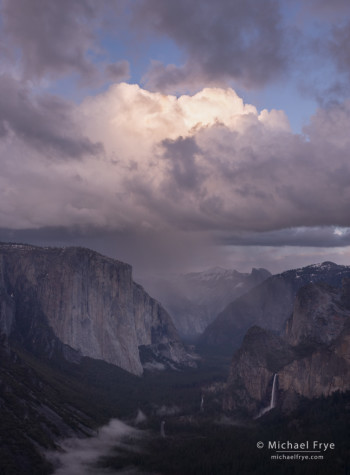
Rain squall over Yosemite Valley from near Old Inspiration Point, Yosemite
Photography encourages us to go to new places, and to be out during the most beautiful times of day when others are asleep or eating dinner. And sometimes – for me anyway – getting to those places can turn into a bit of an adventure.
Last April, on Easter Sunday, Claudia and climbed over 2,000 feet in elevation through rain squalls toward Yosemite’s Old Inspiration Point. We never actually made it there, but we found another good spot nearby, and had a great adventure, as described in my post A Harebrained Idea.
In August, the Rim Fire broke out west of Yosemite. The fire spread rapidly, expanding into Yosemite, and eventually becoming the third-largest fire recorded in California.
I knew this was a big event in the history of Yosemite, so I turned my attention to photographing the fire. During my first attempts I stayed close to the road, as I described in this post. But later Claudia and I made an epic bushwhack to a dome near the Tioga Road, where I captured a panorama of the fire at dusk, shown below.
In my original post about this day I actually didn’t go into much detail about the bushwhack. I’d visited this dome once before, many years ago, to photograph a shapely Jeffrey Pine visible from the road. I remembered it as being a tough hike – only about three miles, roundtrip, but with lots of brush, and clambering over rocks. Yet this seemed like the best place to get a view of the Rim Fire. We decided to go for it, hoping the trip wasn’t as bad as I remembered.
(more…)
by Michael Frye | Sep 25, 2013 | Yosemite Photo Conditions
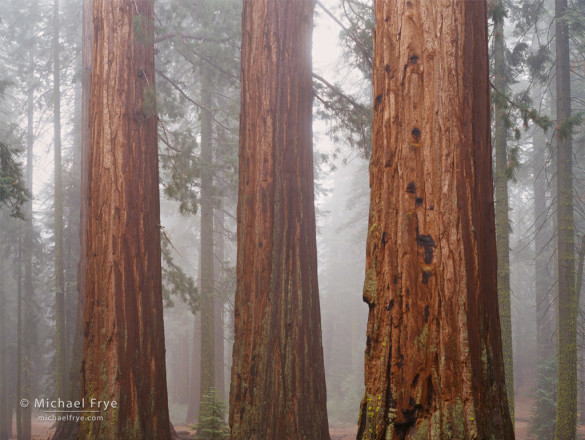
Giant sequoias in fog, Mariposa Grove, Yosemite NP, CA, USA
I thought this was an interesting story in the L.A. Times about efforts to save Yosemite’s giant sequoia trees and old-growth sugar pines during the Rim Fire. Sounds like it was quite dramatic (though perhaps the writer played up the drama a bit).
Today the fire is almost out. They’re still listing it as only 84% contained, but that’s because they’re letting it burn slowly into remote and rocky areas east of Cherry Lake and north of Hetch Hetchy. Elsewhere the fire is smoldering here and there within the containment lines, but rain and snow last Saturday doused a lot of that activity, and smoke from the fire has diminished greatly. All the main roads inside and outside the park are now open.
(more…)
by Michael Frye | Sep 5, 2013 | Yosemite Photo Conditions
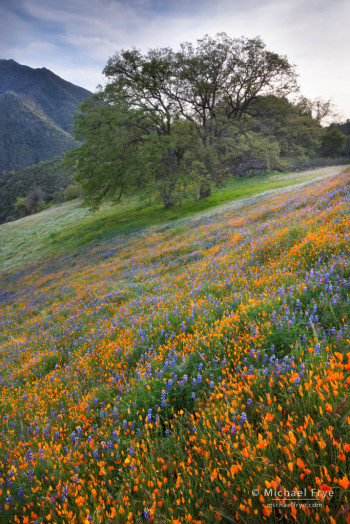
Poppies, lupine, and oaks blooming in an area burned by the 1990 A-Rock Fire, near El Portal, CA (photograph from April 2009)
Yesterday the Rim Fire reached an estimated 237,341 acres in size. That makes it the 4th-largest fire in California since they started keeping records in 1932. It has long since passed the record for the largest fire in the recorded history of the Sierra Nevada. Firefighters continued to make good progress, with containment at 80% as of last night. Even full containment doesn’t mean that the fire is out; it will continue to smolder until the first significant autumn rain or snowfall. But it will mean that firefighters don’t expect the fire to jump their containment lines and spread further.
Since the fire seems to be winding down, it might be a good time to look at some of the long-range consequences of the fire, and put it into perspective in relation to fire management, and the history of fire in this region. I’m not an expert on these matters, but several people who are experts present their views about the causes and consequences of the fire in this New York Times piece. The article includes a striking graph showing the effects of fire suppression during the last 150 years, and links to several other relevant articles. This piece from Wired describes the range of possible outcomes for the burned forest areas, and another article from SFGate covers the reasons why the fire suddenly exploded and burned 90,000 acres in two days.
As I said, I’m not an expert on fire management, but I have seen many fires during my years in and around Yosemite. I have vivid memories of the A-Rock and Steamboat fires of 1990, which closed most of the park for three weeks, and devastated the community of Foresta near the park’s western boundary. My wife Claudia and I lived in Yosemite Valley then, and she was nine months pregnant when the fires started. When she went into labor we had to get special permission to drive through the fire zone to the hospital in Sonora.
(more…)
by Michael Frye | Sep 3, 2013 | Yosemite Photo Conditions
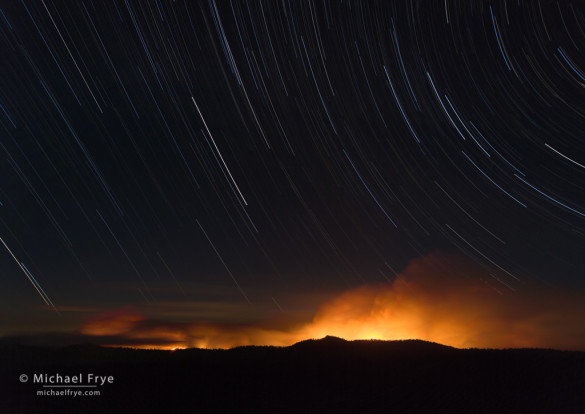
Star trails over the Rim Fire, 8/24/13, Yosemite National Park
On Saturday, August 24th, Claudia and I hiked cross-country to a spot near the Tioga Road with a view of the Rim Fire. I’d picked out this spot, and the route to it, using topographic maps and Google Earth, but you never know until you try it how difficult the route will be, or whether you’ll really be able to find an unobscured view. Fortunately, the hike turned out to be easy, especially compared to our epic bushwhack from two nights earlier. And the view was impressive. The edge of the fire was about six miles away, but the smoke plume was so vast that I couldn’t fit it all in with a 17mm lens.
As the sun went down, I made a series of images of the smoke and fire, some of which are included below. When the sky got dark enough, I set my interval timer to make a series of exposures, each one-minute long, that I could then merge into a star trail sequence. I made about 80 exposures altogether, so the total time for the sequence was about 80 minutes. I then merged the images in Photoshop by setting all but the bottom layer to the Lighten blending mode. You can see the final, merged sequence above. (Here’s link to a post that explains a bit more about this image-stacking technique for star trails.)
(more…)
by Michael Frye | Aug 29, 2013 | Announcements, Yosemite Photo Conditions
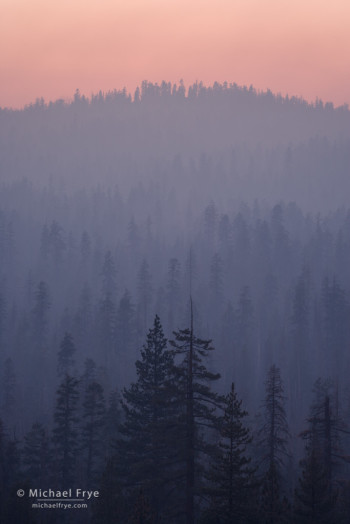
Pastel-colored smoke from the Rim Fire at sunset, 8/26/13, Yosemite NP, CA, USA
I’ve been spending every spare moment photographing the Rim Fire, but I’ve finally had a chance to process some images. I made this photograph Monday evening, as smoke spilled over from the Tuolumne watershed into the Merced watershed near Yosemite Creek, creating a layered view of pastel-colored trees.
The Rim Fire has become the largest fire in the recorded history of the Sierra Nevada, though undoubtedly much larger fires regularly swept through these mountains before Europeans arrived here. At 192,737 acres, the Rim Fire is also the sixth largest in California history, and seems almost certain to pass the Witch Fire (197,990 acres) for fifth place.
The fire’s growth has slowed considerably. Estimated containment for the Rim Fire is 30%, which represents a lot of progress for firefighters within the last few days.
Highway 120 west of Yosemite remains closed indefinitely. Within the park, Highway 120 is temporarily closed from the park’s western boundary to Yosemite Creek. This means that you can’t drive from Yosemite Valley over Tioga Pass to Lee Vining and Mono Lake (or vice versa). You can reach Tuolumne Meadows, Tenaya Lake, etc., by taking another route to Lee Vining, and driving into the park over Tioga Pass, but you’ll have to turn around at Yosemite Creek and leave the park via the same route.
(more…)













